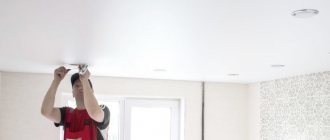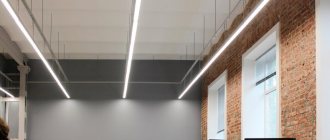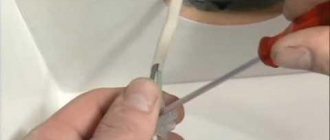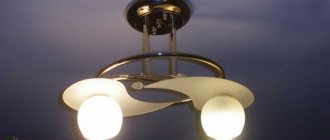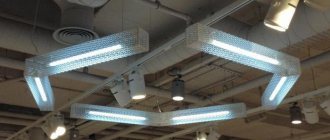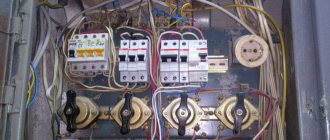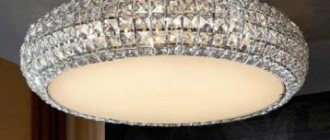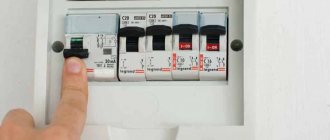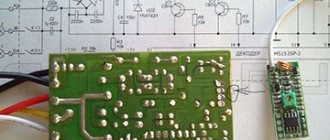Stretch ceilings attract with their unusual texture and perfectly flat surface. Now they are installed everywhere - in offices, trading floors, apartments and houses. The range of canvases is varied: you can choose simple options or complex designs with three-dimensional effects and original designs.
But, before installing such beauty at home, you should think about lighting. After all, installing a chandelier on a suspended ceiling involves many nuances. If you do not take them into account, you can easily damage the surface, hopelessly ruining its aesthetic appearance.
In our material we will tell you how to choose the right lighting fixture, analyze possible methods of attaching lamps to tension structures and give detailed recommendations for do-it-yourself installation. In addition, we will explain what to do in the case when the canvas is already stretched, and the installation of the chandelier was not thought out in advance.
A little about stretch ceilings
Constant attempts to decorate your home, as well as premises intended for receiving people (restaurants, cafes, etc.) leads to the emergence of new finishing materials. This applies to all components of the room, including the ceiling.
Many different materials are used to decorate the ceiling. One of the popular ones now is a suspended ceiling.
It is a thick film, tightly stretched over the entire area of the room.
This allows you to create a perfectly flat flow surface without any transitions or joints. It looks really beautiful.
But the film itself is not placed on the surface of the ceiling; it is fixed to a special frame fixed to the walls of the room, at a short distance from the main ceiling.
In a way, a suspended ceiling can be called a false ceiling that hides the main one.
This ceiling decoration looks aesthetically pleasing and beautiful, but there is a small nuance - the film cannot be load-bearing; trying to attach anything to it will lead to it stretching or tearing. This leads to the need to think in advance about mounting lighting equipment - chandeliers, shades, etc.
A suspended ceiling involves the installation of chandeliers, but this operation has its own characteristics, which we will describe.
So, it was decided to decorate the room with a suspended ceiling. You won’t be able to stretch the film yourself, but you can do the preparatory work to secure the chandelier.
Also read: How to find hidden wiring in the wall.
Selecting a luminaire
Complete instructions for installing and connecting the chandelier
Things to consider when planning lighting:
- Firstly, the cloth is made from PVC film or fabric, which are not heat-resistant materials, so only low-power lamps can be used so that the material of the cloth does not overheat;
- Secondly, the surface of the system is not rigid, since the canvas is made of elastic material, fixed only around the perimeter of the room;
- Thirdly, the material of the panel is quite thin, therefore, in order to properly hang the chandelier on such a base, it is necessary to use additional elements.
Types of lamps for suspended ceilings
The industry produces three types of ceiling light sources:
- hanging (chandeliers);
- built-in;
- invoices.
Suspended devices are mounted on suspended ceilings using suspensions. Conductive cords, chains, cables, etc. can act as suspensions. Unlike other species, they are the heaviest in mass. Some of them are equipped with a variety of shades, which adds additional weight to the device.
Built-in – installed directly into the ceiling system.
Using built-in devices for organizing lighting
Overhead devices are fixed to the plane of the structure.
Recommendations for choosing lamps:
- Point light sources must be equipped with a thermal ring, thanks to which the heated elements of the lamp will not come into contact with the PVC film;
- The temperature of the device parts should not be higher than 60°C;
- There is no need to choose lighting devices equipped with a metal base, since metal is a good heat conductor;
- For lighting, you need to use LED, halogen or fluorescent lamps, since they are low-power and, as a result, emit the least amount of heat. It is not recommended to use incandescent lamps;
Which chandelier is not recommended to be hung from a PVC ceiling:
- with sharp parts (risk of damage to the system);
- if the lamps are structurally directed upwards.
Attention! Incorrect selection of lamps will lead to a reduction in the service life of the suspended ceiling.
Features of choosing a chandelier for a stretch ceiling
First you need to decide on the chandelier itself. When choosing, you need to take into account several parameters to avoid problems in the future:
- You should not select chandeliers with a small height (you need to ensure a sufficient distance between the chandelier lamps and the ceiling film to avoid the possibility of sagging of the film due to the heat generated by the light bulbs);
- It is advisable that all lamps be placed in separate shades (they will additionally protect the captivity from overheating);
- It is better to choose a chandelier that uses several lamps, the more of them, the better (with a large number, even low-power lamps will provide good lighting, and they will not affect the film);
- When choosing, you should pay attention to the protective cap that will cover the wiring, as well as the chandelier fasteners (this cap needs to be large enough. This will primarily facilitate the installation of the chandelier);
- The protective cap should not have sharp edges (to avoid the possibility of cutting the film);
- You need to decide in advance on the fastening method.
Types by method of fastening
Mortgages for lamps for suspended ceilings are of two types:
- fixed;
- universal.
Fixed ones are selected individually for the specific size of the lighting fixture. Their cost is cheaper, but when replacing a lamp, you have to select a new model with the same diameter as the old soffit. Otherwise, difficulties arise during re-installation.
Universal ones are more common due to the fact that they are suitable for installing most chandeliers and spots. During installation, part of the plastic is cut off, leaving a hole of the required diameter.
Methods for attaching a chandelier
The last point mentioned, fastening methods, is the most important for the correct installation of the chandelier on a ceiling covered with film.
Since chandeliers can have several types of fastening, you need to immediately decide on the fastening in order to carry out the preparatory work correctly.
At the moment, three methods of fastening a chandelier are used.
The first - fastening to a mounting hook is the simplest and most common.
It can be used for many lighting devices and can provide both small and fairly large chandeliers.
The second method is fastening to a mounting plate. A small wooden beam is used as a mounting strip, which is attached to the main ceiling, and a chandelier is already attached to it.
Usually used for not very large chandeliers.
The last method is usually used for large chandeliers that have significant weight - mounting on a cross-shaped bar.
Tools and materials
During the work you may find it useful:
- ladder or chair;
- drill, or better yet, a hammer drill;
- pliers (make sure the handles are insulated);
- screwdriver;
- insulating tape;
- wires and terminal blocks for combining two or more sections;
- hook or mounting strip;
- screws, dowels and other fasteners.
Preparatory work
Now about the preparatory work itself. They are carried out even before the film is stretched, but already with a frame mounted on the walls for it. You should immediately decide on the location of the chandelier.
If the room was already habitable, and there was a chandelier in it, there is nothing special to invent, unless, of course, a decision was made to move its location.
The selected installation location must have suitable wiring for powering the chandelier.
If it will be installed in place of the previous one, you should estimate the length of the protruding wire - it should be long enough to ensure easy connection of the chandelier.
If the installation location is moved, or the room is new and there is no wiring yet, you should ensure that the wiring is laid to the place where the chandelier is attached.
Moreover, it is not necessary to hide the wire, because it will be hidden by the film. It is only important to secure it to the main ceiling so that it does not sag.
To ensure that the base for installation does not protrude beyond the level of the film, and at the same time is not far enough from it, you need to stretch a fishing line across the entire room so that it passes through the place where the chandelier is attached.
The ends of this fishing line must be secured to the film frame, and the line itself must be taut. This will allow you to determine the position of the film after it has been stretched.
Next, the base for installation is fastened to the main ceiling. It depends on the chosen fastening method.
Elimination of non-standard situations arising during installation
When hanging a chandelier on a suspended ceiling, situations often arise from which it is not easy to find a way out.
The most common problems among them are:
- The length of the hook installed in the ceiling was insufficient. This happens when there is a large distance between the ceiling and the suspended ceiling. This situation can be corrected by adding a strong chain to the hook - something like an extension cord.
- There was a need to extend the wiring. In this case, all wires are placed in a plastic corrugation. This way they will not sag, which means they will not touch the inside of the tension panel. The corrugation is attached with staples to the concrete ceiling.
- The idea arose to change the location of the chandelier. This should be done in advance, since transfer is impossible without damaging the canvas.
- There is a difference between the wires of a home's electrical wiring and those of a lighting fixture. In such a situation, you need to use special terminal blocks that prevent short-circuiting of non-contact metals from which the wires are made.
In order to correctly perform the rather difficult job of connecting a chandelier to the electrical wiring, you must strictly follow the instructions included with the lighting fixtures. It always describes the entire process in detail and includes a connection diagram. If you do not have special knowledge and skills for such work, then it is better to entrust the installation to professionals.
Installation of the mounting base
Attaching the mounting hook is, in principle, simple. It is enough to make a hole of the required diameter in the main ceiling using a hammer drill, and then screw the mounting hook itself into it.
A stretched line will allow you to correctly select the length of the hook that should protrude. The hook should not reach the fishing line by about 1-2 cm.
Installation of a base made of wooden beams is done a little differently. First you need to decide on the length of the beam itself - it should be the same length or slightly longer than the mounting metal strip that comes with the chandelier.
To secure the beam to the ceiling, a metal construction profile is used.
First, the height at which the beam will be located is measured, and the pieces of the profile required in length are cut off. There must be at least 4 of them to secure the timber.
A stretched line will help determine the level of the film. The lower edge of the beam should not reach the fishing line by 0.5-1.0 cm.
If necessary, the profile can be used as a suspension - this is if the distance from the main ceiling to the film level is significant.
Using dowels, the profile sections are attached to the main ceiling, and the timber is attached to them with self-tapping screws.
Before fixing the beam in the center, you need to make a hole in it for the wiring to come out.
After all installation work, you need to pull the wiring through the hole and secure its ends so that they do not interfere with further work.
If the fastening is using a cross-shaped mounting strip, you will need plywood with a thickness of 10-12 mm.
From it you need to cut a square, identical in size to the cross-shaped bar.
In the center of this square you need to make a hole for the wiring.
Installation of a plywood square is similar to installation of a wooden beam.
First, the position of the square is replaced, all measurements are taken and, using pieces of metal profile, the plywood is fixed to the main ceiling.
Step-by-step instructions for installing a chandelier
All preparatory and installation work, including laying electrical wires, fixing embedded elements and main fasteners for the chandelier, must be carried out before installing the tension fabric. Let's look at all the nuances step by step.
Step #1 - preparing tools and materials
To install the lighting device, you should prepare a set of necessary tools.
First of all, you will need a hammer drill or a hand-held electric drill and a stepladder of sufficient height, which can be replaced with a regular table.
The basic set of tools and materials for installing a chandelier includes: pliers or side cutters with insulated handles, a set of screwdrivers of different types and sizes, including an indicator screwdriver, fasteners in the form of a mounting strip or hook
You will also need:
- switch and distribution box;
- appropriate wires and terminal blocks;
- stripper or other tool for removing insulation from wires;
- drills for concrete and wood;
- pliers or side cutters with insulated handles;
- a roll of insulating tape;
- stationery knife with a sharp blade;
- screws and dowels;
- decorative flask or glass;
- plastic rings for tension fabrics.
In addition, you should find a suitable wooden block or moisture-resistant plywood, which will serve as a mortgage structure.
Before starting the installation process, you should carefully read the instructions that come with the product. Typically, this manual provides detailed recommendations for connecting a specific model.
Step #2 - wiring
The main preparatory stage preceding direct installation is laying the wiring for connection to the electrical network. This work will require knowledge and experience in electrical installation work. It is also important to follow safety rules in this matter. If you have doubts about your own abilities, it is better to use the services of an electrician.
The first step is to draw up a plan with a diagram of the location of all electrical devices that you plan to connect. On the base ceiling, marks are placed in places where lamps can be potentially attached and areas where wires pass are marked.
It is important that the wiring is safe and can provide the required voltage to all devices. Therefore, the choice of a suitable cable must be approached responsibly. The best option for these purposes is a VVGng format cable with a low-flammability sheath.
The cable cross-section is selected depending on the power and number of installed luminaires.
Experts recommend placing the wires parallel or perpendicular to the ceiling and wall joints. Distribution boxes must be installed so that they can be easily accessed for repair or maintenance in the future.
Before starting work, it is necessary to de-energize the room by turning off the power supply in the distribution panel. You can check whether there is current supply using a regular indicator screwdriver.
Then you need to lay the prepared cable to the calculated installation locations of the devices. Open installation behind a suspended ceiling is not recommended: it is wiser to insulate the cable with protective corrugation. This will ensure fire safety of the tension structure, prevent deformation of the coating, possible short circuits and breakthroughs. The corrugated casing is attached to the ceiling slab with brackets.
The cable is routed with a small technological margin. If there is not enough length, you can increase the wire, for which you take stranded wires with a reserve
The wiring is fixed to the base ceiling using special clips or dowel clamps. They should not sag or touch the tension fabric. The recommended fastening step is 50-90 cm. If the wires intersect, they should be additionally insulated at the intersection points. Before stretching the fabric, it is important to check the voltage supply for each lamp.
We discussed in detail the main nuances of proper electrical wiring with our own hands in this article.
Step #3 - preparing the base
Preparation of the base depends on the chosen option for hanging the chandelier.
In the case of hook mounting, it is enough to drill an opening in the concrete surface of the ceiling equal to the diameter of the fastener. Usually it is 6-14 mm, which depends on the weight of the device. If the length of the hook is not enough for fastening, you can supplement it with a strong chain.
The anchor bolt is inserted into the prepared hole at the required height and tightened with a hanging nut. It should fit closely to the inner surface of the armhole
In private homes, a through fastening method can be used:
- a through hole is made in the interfloor slab;
- one plate is placed in the floor of the upper floor or in the attic, and a second one under the ceiling;
- take a hook and screw on a nut that will hold the plate;
- the hook is pushed into the ceiling hole, another nut is screwed on top, which will tighten the plates.
For hollow-core floor slabs, another method is suitable.
It provides for the following types of work:
- a hole of the required size is made in the ceiling;
- reinforcement is inserted into the hole, the length of which is selected depending on the thickness of the slab;
- a hook with a ring at the end is made from wire rod;
- Reinforcement, previously placed in the hollow channel, is placed on the hook.
If the chandelier will be mounted on a mounting plate, you need to install a mounting made of a wooden block, durable moisture-resistant plywood or ready-made plastic platforms of a round, square or cross-shaped shape.
It is desirable that the dimensions of the embedded part coincide with the base of the lamp, and the thickness is 2-5 mm less than the distance from the base ceiling to the tension fabric line. The edges of the wooden beam must be sanded well
The wooden block is attached to the concrete base with long self-tapping screws and dowels, which are inserted into the holes made with a hammer drill.
If plywood is used as a mortgage, metal legs should be attached to it for fixation. For larger devices with a mounting cross, a more solid, thick support is required.
Step #4 - attaching the chandelier to the ceiling
After installing the stretch ceiling, you will need to cut holes of suitable sizes in the places where the hook or mounting strip is attached. A thermal ring is previously glued in this area, which will protect the material from overheating and prevent it from breaking apart.
The procedure is quite simple: carefully lubricate the adjacent surface of the ring with glue, attach the part to the ceiling and press lightly. The size of the hole should be slightly smaller than the diameter of the base of the chandelier.
To strengthen the film in the places where the chandelier is attached to the embedded base, small tread rings or reinforced tape are used
After the glue has set, all that remains is to cut out the film in the inner space with a stationery knife. Electrical wires are pulled out through this hole. The neutral wires are connected into one bundle, and the phase wires are separated if a double switch is installed in the room.
You can check where the zero is and where the phase is using an indicator screwdriver by turning on the power supply. For convenience, it is worth marking the phase and neutral wires with different colors.
The longitudinal mounting plate is carefully attached to the embedded base with self-tapping screws on top of the tensioned web within the hole limited by the ring
To install the crosspiece, five holes are made in the finished tension fabric: one large one in the middle for wires and four small ones for fixing the strip to a wooden platform proportional in size.
Thermal rings or cut out pieces of plastic are glued to the joints. The fastening of the I-beam is similar to the cross-shaped one, with the exception of minor differences in the method of connection to the platform.
The base of the chandelier should be placed on a bar, secured with studs and nuts, or hung on a hook by a loop.
Step #5 - connecting to the electrical network and eliminating deficiencies
Upon completion of all installation work, the chandelier is connected to the electrical network and its functionality is checked.
To do this you need to do the following:
- Turn off power.
- Check the presence or absence of voltage in the wires with an indicator screwdriver.
- Strip the ends of the wires of the installed lamp and the supply wire of the home electrical network by approximately 6 mm, connect them correctly and fix them in the terminal box. We recommend that you read the detailed guide on connecting a chandelier to a two-key switch.
- Turn on the power supply in the panel, make sure that the lamp is working and the lamps are burning normally.
- In case of problems with the operation of the device, check the light bulbs, the switch on the wall, the integrity of the contacts and wiring on the path from the switch to the device, and the wire connections in the chandelier.
The final step when hanging a chandelier on a hook is to install a decorative glass or ceiling rosette. In the first case, you need to hide the wires, carefully lift the cap as far as it will go and fasten it with decorative nuts. And we described in detail the installation of a ceiling rosette in the following material.
If the interior design of the room requires it, to decorate the place where the chandelier is attached, you can use lightweight polyurethane rosettes of different diameters, imitating gypsum stucco.
When screwing or hanging the lamp, you should not overdo it and use unnecessary force, since the tension fabric can easily deform.
At the end, you should inspect the surface, carefully checking its integrity. If there are tears, scratches or chips near the installation site, you should try to eliminate them. For example, use special thermal adhesives to hide defects, carefully glue the torn ends of the film with tape, and add a masking pattern along the entire line of damage.
Attaching the chandelier to a hook
The first step is to find the location of the hook. You can press lightly on the film to find the hook.
You need to glue a heat-resistant ring to the place where it is located. Its diameter must be selected depending on the size of the hole that will be needed to access the mounting platform.
During further work, it will not damage the film sheet.
The ring is glued with superglue, and you need to make sure that the glue is on the entire surface of the ring, which will be pressed against the film.
Omissions are unacceptable, as they can lead to tearing of the fabric.
After gluing the ring, you need to check the tightness of its fit. Then, using a construction knife, a hole is cut in the film to access the hook.
The wiring is pulled out through the hole. Afterwards the chandelier is hooked onto the hook and the wiring is connected. The sagging wire is hidden under the film.
All that remains is to lift the protective cap to hide the hole and fasteners of the chandelier.
Preparing the wiring
Regardless of the chosen installation method, before installing the tension structure, you must prepare the wiring for the lighting fixtures in advance. To do this, turn off the power in the room or apartment and stretch the wires from the distribution box of the room to the installation site of the chandelier. They are laid through another place where the switch will be located. If it is already installed, then the wires are routed directly from it. Be sure to leave a reserve and insulate the cable well to prevent short circuits and electric shock during the installation of suspended structures.
Since the wires will be hidden under the PVC structure, an open installation method is acceptable. For those who want to play it safe, it would not be superfluous to use corrugated boxes, grooves or other closed wiring options. If there are no wires of the required length, then connections of two or three different sections must be made through terminal blocks. Conventional twisting or soldering is inappropriate here.
Installing a chandelier on a mounting plate
Installing a chandelier on a beam is done a little differently. First you need to find the location of the timber, and stick a heat-resistant ring in this place.
In this case, its diameter should be such as to ensure ease of access to the beam, but it should not be larger than the size of the protective cap.
Then the mounting strip of the chandelier is secured to the beam using self-tapping screws. When tightening the screws, it is important not to press them in completely so as not to bend the plate.
Next, the wiring is connected, and then the chandelier itself is attached to the mounting plate.
All that remains is to hide the wiring and cover the hole with a protective cap.
Mortgage for a chandelier
The simplest way to install a lamp involves the use of a special element fixed to the rough ceiling surface even before the tension fabric is attached.
This can be a wooden block or a piece of plywood 15x20x3 cm, sewn to a concrete slab using dowels, fixed with corners or hangers for plasterboard ceilings.
The embedded part remains hidden behind the tension fabric, so its shape and dimensions are not particularly important, as long as the installation level matches or is slightly higher than the ceiling cladding. The absence of a rigid connection between the bookmark and the canvas makes it possible to move the decorative trim, which means that if horizontal forces arise, you can be sure that the chandelier fastening will not break the finishing materials.
One of the mortgage options
Different types of fittings require a base of different sizes. Most often you can find a regular rectangular plate, which should be attached to the ceiling with screws.
A simple rectangular plank will require a very small mortgage, usually made from a block of wood. This type of fastener is used for most lighting fixtures.
The cross-shaped plate needs to be fixed with several screws, and the base needs a larger one. This type of fittings is used for round, square and oval lamps. Basically, these models are quite massive, so the strength of the prepared site must be appropriate.
After installing the mortgages, you should mark on the canvas the points where the screws will be screwed in. These places must be reinforced with pads or O-rings, otherwise the film will tear.
Many houses already have plasterboard structures installed, which you don’t want to give up. They are often combined with “soft” coatings. Together, these two types of finishes harmonize perfectly.
But if several light sources are planned, one of which will be located on a gypsum sheet, the same set of preparatory work will be required as with stretched ceilings.
Important: plasterboard ceiling is not suitable as a base. Heavy lighting fixtures cannot be attached to it.
When these operations are successfully completed, you can stretch the PVC film.
Important: the height of the embedded structure must exactly correspond to the plane of the stretched fabric or film.
If you do not pay enough attention to this point, the result may not be satisfactory.
Mounting strips
At the present stage of technology development, stretch ceilings are very popular and the installation of a chandelier on them is carried out using a special method. How to hang a lamp correctly? Mounting strips are used quite often. It is very important to hang the chandelier correctly, and do not install it on a concrete base. It would be more advisable to hang the chandelier using strips only if the beams are wooden.
We hang the chandelier on the suspended ceiling with slats if plywood is used as a special insert. It is attached to concrete. It will not be possible to replace plywood with plasterboard, since the planks are not suitable for this material. When the embed for the chandelier in the suspended ceiling has been selected, you can proceed to the main stage - installation.
Choosing a chandelier for a stretch ceiling is not difficult if the fastening mechanism is clear. The stretched material is secured at the initial stage with a special thermal ring. Before you decorate suspended ceilings with a chandelier, you need to clearly determine the place where the lamp will hang. It is there that the wire must be run, through which the supply of electricity will be realized. How to choose the right diameter? It should not be larger than the glass of the lamp itself.
A chandelier for a bedroom with a suspended ceiling can be hung in any convenient way. After the work has been done, it is necessary to connect the wires. It is very convenient to hang a lighting fixture on a suspended ceiling using a mounting strip. It should be taken into account that the hole in the thermal ring must comply with the standards. The device will be fixed as successfully as possible if all parameters are selected accurately.
The ceiling chandelier will function only after the last stage is completed: you need to connect the wire to the terminals (they are located in the wiring). Hanging material with an already working device will look very impressive.
Marking the ceiling for lamps
All work on preparing fixtures for lamps and installing wiring is carried out before stretching the fabric. There can be a huge number of options for the location of lamps. Let's look at some of the most popular and versatile ones.
Distribution of lamps in a circle in the center of the room. To make the markings we will need: tape measure, pencil, painting thread, self-tapping screw. First you need to find the center of the room. This is done using a painting cord. If the room is rectangular, then this is quite easy to do. Pull the cord from one corner to the opposite corner diagonally and mark a line on the ceiling. Do the same with the other pair of corners. The intersection of the diagonals will be the center of the room. Next, we need to decide on the radius of the circle along which we will mount the lamps. We measure it from the center of the room in any direction. Then we attach a self-tapping screw in the center of the room and tie one end of the thread to it. We wind the second end around the pencil so that the pencil is on our mark and the thread is taut. Without losing the tension of the thread, we draw a full circle on the ceiling. To calculate the distance between the lamps, we need to calculate the length of the circle. This is done using a simple formula from the school geometry course: 2Pr, where R is the radius of the circle, P = 3.14. Next, divide the resulting number by the number of lamps and plot the distance in a circle.
Consider the option of placing lamps in an arc anywhere in the room. In order to create an arc, we need at least 4 lamps. But remember, the more lamps, the smoother the arc will look. First we need to choose a place to install the end platforms. It should be taken into account that the distance from the wall to the lamp should not be less than 40 cm, and best of all 60 cm. The fastest and easiest way to draw an arc is to use a plastic baguette. Due to its flexibility, it is perfect for drawing smooth lines. Place the baguette whip on the ceiling, bending it in the desired direction, and draw a line. Deflection can level the smoothness of the arc. After this, we measure the arc, and divide the resulting number by the number of lamps minus one. If the figure along which the lamps are placed is not closed (circle, oval, square), then the distances between the points will be one less than the number of points themselves. Also, to draw an arc on the ceiling, you can use the circle method. Just draw not the entire circle, but only part of it.
And the third option: placing spotlights in a straight line. For marking we will need a pencil, tape measure and painting cord. Mark the outermost fixtures, taking into account the symmetry of the room. Click the painter's thread along the lines between them. You also need to calculate the distance between points: the number of lamps minus one, we get the number of gaps. We divide the total length of the line between the lamps by the number of spaces, the resulting number will be our distance.
Criteria for selecting lighting fixtures
When choosing lighting fixtures for a stretch ceiling, you should take into account the features of its design
When selecting a lamp, several features should be taken into account:
- When choosing a base for a ceiling chandelier, you should not purchase a design with a metal base so that the ceiling is not subject to heating.
- To prevent damage to the ceiling, it is important to ensure that there are no sharp elements pointing upward on the chandelier.
- The location of the lamps from the canvas should be 35-40 cm.
- It is recommended to give preference to models with several light bulbs with low power.
When choosing a chandelier for a room with a high ceiling, it is worth purchasing a model with several tiers.
